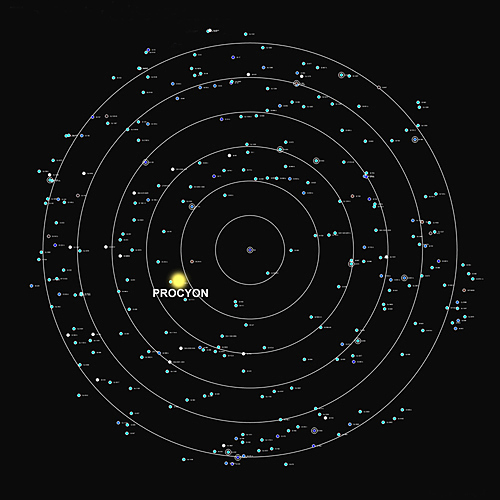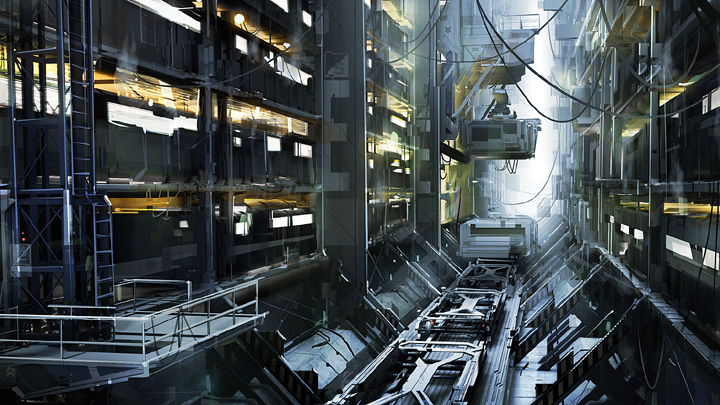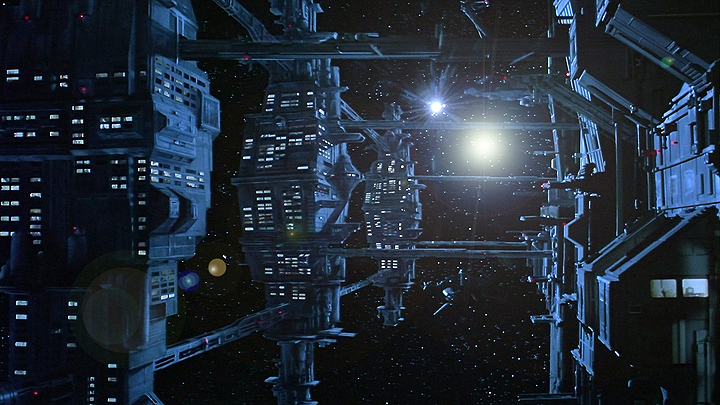
DISTANCE: 11.5 light years from Sol
NEIGHBORING SYSTEMS: Sirius 5.2 lys Alpha Centauri 13 lys Groombridge 1618 13.1 lys
PROCYON is a binary star system which consists of both a large yellow-white dwarf and a small white dwarf companion with an average distance between them of only 14.9 AUs. Procyon A is twice the size and over seven times brighter than Sol. This star is orbited by four planets which includes two small rocky worlds and two gas giants. Beyond this is a dense cloud of rocky debris which is believed to be the remnants of failed proto-planets that were torn apart during the early history of this system. Procyon B is incredibly dense and compresses its entire stellar mass into a planetary volume. Although there are no planets orbiting this star, the entire local region is permeated by a thick cloud of dust. This binary pair is approximately 140 percent as enriched with metals as Sol and, much like the Sirius system, the entire region contains high concentrations of Teslium ore.
JOTUNHEIM is the fourth planet in orbit around the primary star and is the larger of the two gas giants in this system. It has nearly twice the overall mass of Jupiter with a dense ring made up of ice and rocky debris and is composed primarily of hydrogen, helium, and ammonia. This world has an intense internal heat source and radiates an enormous amount of energy of its own. Jotunheim also has a total of 27 moons in orbit, the largest of which, called Nerthus, has the highest concentration of Teslium deposits in the entire system.

After sending an unmanned survey probe to investigate the Procyon system, scientists soon discovered that, like Sirius, it was yet another key source of Teslium ore. In 2152, the Reinhold Corporation committed itself once again to establishing a new permanent mining industry and made this the fifth system beyond Sol to be colonized by Humans. A new modular space station was constructed just outside of the main radiation belts of the gas giant, Jotunheim. SINDRI STATION soon became both the primary base of operations for their mining facilities and the permanent residence of the company employees and their families.
While there are several obvious similarities to the outpost in the Sirius system, there are many distinct differences as well. The majority of SINDRI STATION’s population is made up of former Indentured Workers who were offered the opportunity to become registered Free Workers with the Reinhold Corporation. Many of these individuals had already spent decades working and living together in the mining colonies on Jupiter’s moon, Callisto. From early on, they had learned to depend on each other in every aspect of their lives and now, brought together once again in a new frontier, they felt even more like an extended family. The Proceans, as they eventually began to call themselves, are hard-working, strong-willed, and extremely independent. They spend a great deal of their free time gathered together to share in evenings of drinking, singing, and telling stories. Although they tend to be somewhat guarded when it comes to outsiders, they are warm and welcoming to their honored guests and are loyal to a fault towards people they consider their friends.
Though this outpost was originally designed more for industrial usage rather than comfort, dozens of additional modular units have been added; including several hydroponic and agricultural compartments for growing their own food. According to the official census in 2233, SINDRI STATION now provides both residential and workplace environments for nearly 395,000 people.

Because this outpost was established for the sole purpose of harvesting resources, the inhabitants were long regarded simply as company employees rather than traditional colonists. They had no provisional government and were under the direct authority of the Mining Guild for 45 years. A Guild Baron was appointed as the regional administrator to regulate and oversee the entire operation. Since the initial discovery of large quantities of Teslium ore, numerous extraction facilities have been established on several of Jotunheim’s larger moons. Over the years, this outpost has supplied a variety of valuable resources to Earth and many of its colonies to become one of the most lucrative mining communities ever established.
The TYR shipyards were established within the first few years of colonization, however, this facility was initially only equipped for the construction of sub-light freighters and mining vessels to be used within the confines of the system. For three decades, the Proceans were forced to depend on outsiders for all of their interstellar distribution needs; which included the shipment of refined Teslium and the transportation of technical equipment, supplies, and new workers. This often made them feel even more disconnected from the interstellar community as a whole, but it also brought them closer together as a society.

When the Human race first encountered the Zendathu in 2182, the Reinhold Corporation doubled its security and began to relocate all of its commercial operations out of the Sol system in order to make its interstellar properties its primary concern. This company also increased its overall workforce and began to utilize the TYR shipyards to construct its very own fleet of battlecruisers in preparation for any possible future attacks.
As a war between the two species began with the assault on the Groombridge 1618 outpost, the Proceans readied their own defenses for a possible invasion. Two days after the devastating loss of COPERNICUS STATION, the Zendathu invaded the Procyon system as well. Their security forces were already on high alert and were, to some extent, more prepared to defend themselves. The colonists living on SINDRI STATION were fiercely protective of their home and took up arms against a Zendathu vessel that had forcibly docked with the station. Witnesses to this event said that the colonists fought like “Berserkers” as they boarded the ship and incapacitated the alien crew. Their heroic actions allowed their security forces to gain the upper hand and destroy a second enemy vessel before the third managed to escape.
The Proceans, who are extremely proud of their Germanic and Nordic ancestry, later formed their own private militia and adopted the title Berserkers in honor of their distant Viking heritage. Throughout the long conflict, as one system after another came under relentless attacks, the Proceans fought alongside the other colonies and proved themselves to be a force to be reckoned with in the fight against the Zendathu.
After the war, the UEC began to enforce several unpopular policies upon many of its colonies. These new regulations eventually led the Reinhold Corporation to protest by ceasing all further shipments to Earth. The UEC warned that, if shipments didn’t resume immediately, a permanent military presence would be assigned to the outpost and martial law would be established. Fearing a corporate takeover and knowing that their security forces alone were no match for SolCorp’s massive fleet, the Proceans turned to their allies in the Alpha Centauri system for support. A group of representatives from Procyon, Sirius, Groombridge 1618, and Alpha Centauri were selected to convene on Beta Prime where they signed “The Centauri Accords” which officially declared their complete separation from Earth’s corporate empire. These accords were also the catalyst in creating the Centauri Union which not only merged these colonies together under one interstellar government, but provided military defense and economic support to all of its members.
SINDRI STATION is located on the distant edge of the main shipping routes and is known to most simply as a refueling outpost and a Teslium ore distribution center. Because of this, the majority of its visitors are freighter crews and mid-level traders who welcome the station as an overnight respite during long, arduous journeys. Yet, the Proceans themselves have become quite skilled in manufacturing high-end weaponry and supply a large amount of handheld armaments to many of the independent colonies. To this day, the colonists in this system remain fiercely independent and very protective of both their home and their way of life.